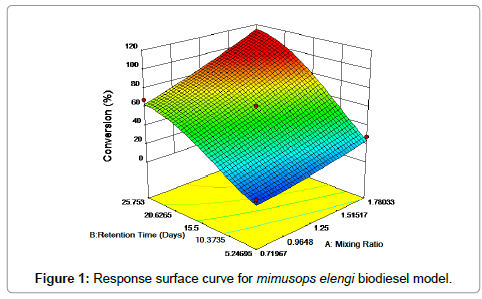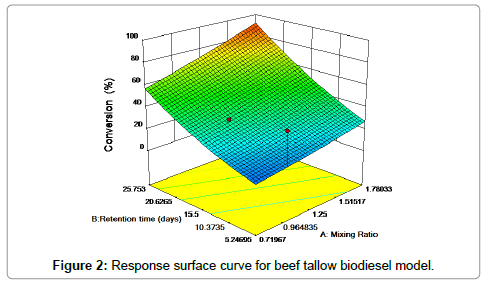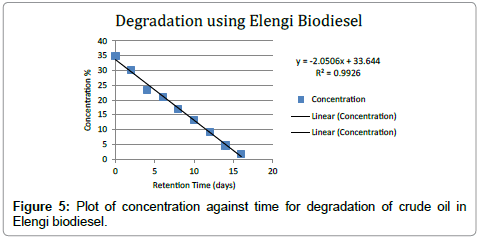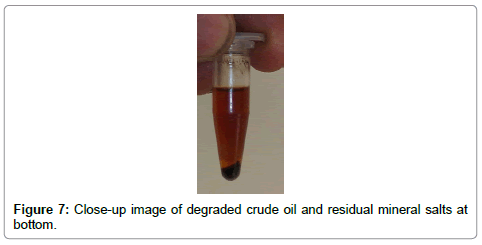Degradation of Crude Oil Using Biodiesel Produced from Seeds of Mimusops Elengi and Waste Beef Tallow
Received: 17-Jan-2018 / Accepted Date: 20-Feb-2018 / Published Date: 26-Feb-2018 DOI: 10.4172/2157-7617.1000444
Abstract
This paper deals with the study of degradation of crude oil using biodiesel from two different sources having different degree of saturation. Biodiesel is normally produced for meeting the energy demand in the market, can also be used for the degradation purpose because of its solvent nature on hydrocarbons. This property is used to degrade the crude oil by dissolve the complex hydrocarbon chains in it, thereby reducing its viscosity and enhancing its handling. The feedstocks used for biodiesel production are oil from seeds of Mimusops elengi (unsaturated oil) and waste beef tallow (saturated Fat). The biodiesel was produced by the means of base catalyzed methanol transesterification reaction. The most optimized blending ratio between crude oil to biodiesel was found to be 1:1.95 (crude oil: biodiesel) for elengi biodiesel and 1:1.85 (crude oil: biodiesel) for tallow biodiesel and the retention time for elengi oil and tallow biodiesel was found to be 16 days and 24 days respectively. The maximum degradation rate that was achieved by this technique was 95%. This method proves to be a renewable option for degrading the spilled crude oil during wreckages with limited environmental concerns in ecofriendly manner.
Keywords: Degradation; Crude oil; Mimusops elengi oil; Beef tallow; Transesterification; Response surface methodology
Introduction
Since the era of internal combustion engine began in late 1800s, the commercialization of fossil fuels for fuelling these engines, have been expanding widely in a rapid manner starting from urban cities later on moving to rural and remote villages. The market for these fossil fuel has grown to greater extent, where the total shipment value of crude oil exported during the year 2015 was alone US$786.3 billion [1], thus making it the world’s leading export product. In order to meet the market demand, these fuels are shipped in huge quantity through oil tankers and also at times, through underwater pipelines in form of raw crude oil. With increase in rate of oil transportation, the rate of this oil being leaked into sea accidently has also increased drastically. This leakage of crude oil into marine bodies due to motor vessel accidents, equipment failures, natural disasters and operations & management faults is technically termed as oil spill and usually categorized as grade 1 man-made disaster. The oil spill is categorized based on the volume of spillage i.e., <7 tonnes, 7-700 tonnes and >700 tonnes (<50 bbls, 50-5,000 bbls, >5,000 bbls), where majority of spillage falls under the category of <7 tonnes [2]. On November 2002, single hulled oil tanker Prestige, shipping a payload of 77,000 tonnes of M-100 Russian fuel oil (equivalent to the ASTM no. 6 heavy fuel oil), caused an oil spillage upon impact with a severe storm near Cape Finisterre, causing a spill across 1900 km wide shoreline in northwest and north Spain and west France [3]. The spillage at Singapore during January 2015 resulted in a leakage of 4,500 tonnes of crude oil whereas the turkey spillage was 1,400 tonnes of naphtha (derivative of crude oil) [2]. Even though the rate of oil spill has reduced to 1.8 per year, their impact on environment and its surrounding components faces serious threats and hazards. Numerous sea animals and marine birds are affected because of this oil spill, and the quality of marine water body is compromised, thereby affecting the whole marine ecosystem. The biotic part of marine ecosystem has the ability to self-heal climatic anomalies (e.g. El Niño), anthropogenic pressure and storms and oil spills until its threshold limit, beyond which recovery is practically complex. So in order to restore the marine ecosystem back to normal condition, the spill must be cleared and removed from water bodies and washed to the shore. This cleaning process must be reacted immediately, as delay in the process increases the causality rate to a greater extent. Various methods like burning the crude oil, pumping it out has been employed to remove the crude oil from the spillage zone. These solutions seem to be effective but are temporary as it lands up in environmental pollution in addition to the damage caused due to spillage. As part of solving this issue effectively, biodiesel, an ester based product is used to degrade the crude oil spillage without any side effects to the environment.
Biodiesel is a non-volatile solvent with zero toxicity and high degradability [4], that can be used to degrade crude oils from spillage zones and contaminated soils without any adverse side effects [5-7]. The degradation of crude oil using biodiesel is based on the unique solvent property on hydrocarbons. Crude oil is homogeneous combination of long chain aliphatic cyclic hydrocarbons, polycyclic aromatic hydrocarbons (PAHs) and alkyl benzenes, as well as their derivatives such as toluene, xylenes and PCBs (phenyl and biphenyls) make the crude oil chemical complex. [8]. Biodiesel speeds up the degradation of crude oil and use of microorganisms readily attacks the carbon source which makes it more degradable [8,9]. The oil spills occurs at sea where volatile compounds like short chain aliphatic gets easily evaporated whereas low volatile compound like poly aromatic hydrocarbons (PAHs) and long chain aliphatic gets carried to the shore by the waves which leads to the contamination of beaches. Because of its solvent property, it has ability to mobilize nonvolatile waxy components by dissolving it and enabling it to easy get carried away by water that the biodiesel is a readily biodegradable compound by employing EPA method [8]. Based on literature study, researchers verified that in some cases biodiesel can be applied in contaminated areas as an enhancement agent to bioremediation processes [7,10-13]. In this work, the degradation of crude oil is carried out using two different biodiesels with different degree of saturation and study their impact on rate of degradation. In addition, the crude oil to biodiesel mixing ratio and retention time was optimized for both biodiesel using optimization tool. This methodology can be considered as greener technology for solving oil spill than any other traditional techniques as biodiesel is also a carbon neutral fuel.
Materials and Methodology
Collection of crude oil
The crude oil sample was collected from a crude oil dealer and the sample was preserved at room temperature directly exposed to ambient condition in order to attain the weathered conditions before treatment.
Production of biodiesel
The biodiesel was prepared from the waste beef tallow and Mimusops elengi seed oil. The fat and oil was initially refined by treating with ortho phosphoric acid and were pretreated through glycerolysis and esterification respectively, to reduce the FFA and was then transesterified separately by reacting with methanol and potassium hydroxide. The biodiesel-glycerol mixture was separated and biodiesels were washed thoroughly to remove any unreacted compounds and left over catalysts and salts.
Experimental setup
The effectiveness of degradation was studied by mixing the crude oil with biodiesels in various ratios. The crude oil: biodiesel mixture was mixed in three different ratios 2:1, 1:1, 1:2 for both elengi oil and beef tallow biodiesel [7]. The samples were mixing thoroughly for even mixing and were allowed to get degraded by the polymeric corrosion by biodiesel. The quantity of these samples was limited up to 10 ml for each blend and was filled in graduated test tubes. The 10 ml makeup of the mixture was carried out based upon the respective mixing ratio. The sample was left untouched for 30 days and the amount of degraded content was measured on daily basis.
Results
The biodiesel was produced from oil of Mimusops elengi and beef tallow by the means of base catalyzed methanol transesterification reaction. The pretreatment for elengi oil was done by esterification reaction whereas beef tallow was pretreated through glycerolysis reaction. The catalyst concentration was maintained as 2% and 0.5% for elengi oil and beef tallow respectively. The most optimum feature employed for the biodiesel are enlisted in Table 1.
| Parameters | Mimusops elengi Oil | Waste Animal Fat |
|---|---|---|
| Extraction Method | Soxhlet Extraction | Autoclave Extraction |
| Refining Method | Degumming | Degumming |
| Processing Technique | Esterification Reaction | Glycerolysis Reaction |
| Solvent Used | Methanol | Glycerol |
| Catalyst (for Pre-Treatment) | Sulfuric Acid | NA |
| Preparation Technique | Transesterification Reaction |
Transesterification Reaction |
| Molar Ratio | 1:6 (oil:methanol) | 1:6 (oil:methanol) |
| Catalyst Concentration | 2% KOH | 0.5% KOH |
Table 1: Optimum parameters for production of Biodiesel.
The optimization of crude oil degradability in biodiesel was carried out using Central Composite Design under response surface method in design expert 10. The mixing ratio between crude oil & biodiesel and retention time were considered as independent input variables whereas the conversion efficiency was considered as output variable. The total number of experiments was 14=(2k+2k+6), where k is the number of independent variables [14]. The mixing ratios (crude oil: biodiesel) were maintained as 2:1, 1:1 and 1:2 for both mimusops Elengi seed oil and tallow based biodiesel and was studied for 30 days [7]. The conversion efficiencies for varying mixing ratio and retention time were calculated experimentally and the amount of crude oil dissolved in biodiesel was calculated using 3/27 method. Tables 2 and 3 tabulates the changes in the concentration of crude oil in biodiesel from elengi oil ester and tallow ester respectively.
| Crude oil: Mimusops elengi biodiesel Degradation Rate (%) |
|||
|---|---|---|---|
| Days | 2:1 (Crude oil: biodiesel) | 1:1 (Crude oil: biodiesel) | 1:2 (Crude oil: biodiesel) |
| Biodiesel Concentration | 33.33% | 50% | 66.33% |
| Crude Oil Concentration | 66.33% | 50% | 33.33% |
| 0 | 0 | 0 | 0 |
| 5 | 8 | 15 | 35 |
| 10 | 11 | 38 | 60 |
| 15 | 20 | 52 | 95 |
| 20 | 33 | 66 | 95 |
| 25 | 41 | 95 | 95 |
| 30 | 50 | 95 | 95 |
Table 2: Degradation rate of blended mixture for biodiesel from elengi oil ester.
| Crude oil: Beef Tallow biodiesel Degradation Rate (%) |
|||
|---|---|---|---|
| Days | 2:1 (Crude oil: biodiesel) | 1:1 (Crude oil: biodiesel) | 1:2 (Crude oil: biodiesel) |
| Biodiesel concentration | 33.33% | 50% | 66.33% |
| Crude oil concentration | 66.33% | 50% | 33.33% |
| 0 | 0 | 0 | 0 |
| 5 | 2.7 | 10.1 | 26.3 |
| 10 | 6.9 | 24 | 42 |
| 15 | 13.2 | 37.1 | 58 |
| 20 | 21.3 | 46 | 77 |
| 25 | 36.7 | 58 | 95 |
| 30 | 43 | 75 | 95 |
Table 3: Degradation rate of blended mixture for biodiesel from tallow ester.
Conversion Efficiency (Elengi Biodiesel)=2.77076 + 2.46585*Mixing Ratio + 0.66897* Retention Time -0.012654*Mixing Ratio*Retention Ti me (1)
Conversion Efficiency (Tallow Biodiesel)=11.00703 - 5.13490*Mixing Ratio - 0.033600* Retention Time -0.036916*Mixing Ratio*Retention Time + 1.22209* Mixing Ratio2 - 1.45976E-003* Retention Time2 (2)
Equation 1 explains the conversion efficiency in terms of mixing ratio and retention time, as variable parameters for the mimusops elengi biodiesel model. The Fisher F-test (Fmodel=27.39) with a very low probability value ((Pmodel >F) <0.0002) shows a very high significance of the regression model at 95% confidence level. The “P-value” less than 0.05 indicated that the particular model term is statistically significant. The two model terms studied i.e. mixing ratio (A), retention time (B) were found to have significant influence on the degradation rate.
The interaction between mixing ratio (A) and retention time (B) and quadratic terms A2 and B2 and AB were also found to be significant. Figure 1 depictes the response surface curve for mimusops elengi biodiesel model.
Equation 2 explains the degradation rate in terms of mixing ratio and retention time, as variable parameters for the beef tallow biodiesel model. The Fisher F-test (Fmodel=32.38) with a very low probability value ((Pmodel>F)<0.0001) shows a very high significance of the regression model at 95% confidence level. The “P-value” less than 0.05 indicated that the particular model term is statistically significant. The two model terms studied i.e. mixing ratio (A), retention time (B) were found to have significant influence on the degradation rate. The interaction between mixing ratio (A) and retention time (B) and quadratic terms AB, A2, B2 were also found to be significant. Figure 2 depicts the response surface curve for beef tallow biodiesel model.
Discussion
Based upon the statistical models, the most optimised degradation blend for mimusops elengi oil biodiesel was found to be 1.95 for a retention time of 16 days whereas for tallow-based biodiesel, it was found to be 1.85 with a retention time of 24 days. Maximum degradation rate was found to be 95% for both blends, thereby assuming the remaking 5% as residual mineral salts and non-dissolvable contents. Furthermore, the rate of degradation of crude oil by both biodiesel samples were analyzed from the initial set of experiemntal data and studyig the optimized parameters. Figure 3 explains the change in concentration of crude oil with respect to time when mixed with biodiesel from elengi oil and beef tallow. It can be inferred that the rate of the degradation increases as the quantity of biodiesel increases. The availability of the biodiesel facilitates the degradation of the crude oil at a faster rate. This is because, crude oil is a high viscous synthetic polymer with combinations of various long chain aliphatic and aromatic hydrocarbons mixed with inorganic mineral salts. The solvent property of the biodiesel causes these hydrocarbons to dissolve in it thereby reducing its viscosity and also making the inorganic compounds to settle down at the bottom. At initial stages, the biodiesel starts mixing with the crude oil sample and starts degrading it slowly by dissolving the long chain hydrocarbons thereby decreasing its viscosity and simultaneously separating the nonfatty compounds, allowing them to settle at the bottom by the action of gravity. Figure 4 shows the degraded crudeoil- biodiesel mixture for varying mixing ratios.
Also, it can be noted that the activity of degradation of crude oil using the biodiesel from both elengi seed oil and beef tallow revelead that the rate of degradation was found to be higher and rapid in unsaturated biodiesel (elengi oil biodiesel) than saturated biodiesel (beef tallow biodiesel). This is because of the the unsaturation in the fatty acids derived from the triglyceride and the kinks in the hydrocarbon chain has a greater influence in the degradation of the crude oil. This results in faster degradation than compared to saturated biodiesel.
The rate of the reaction in which the crude oil is degrdaded in biodiesel by the solvent action is calculated by using Equation 3 [15].
Rateof Re action (r) =  (3)
(3)
Where, C=Decrease in concentration of crude oil
K=Rate Constant
On intergrating equation 3 with respect from concentration at t=0 (intial concentration) to concentration at t=t (final concentration), we get:
Ct=Co-Kt (4)
Where, Ct=Concentration at time t
Co=Initial Concentration
The effect of the biodiesel concentration on the kinetic constant was neglected as the concentration remained constant throughout the experiment. The rate constant k, was determined by plotting a graph for the linear equation between the time in x-axis and the corresponding concentration (Ct) in Y-axis, where slope of the line provided the value of K.
The actual conversion efficiency on crude oil was evaluated based upon the experiemental investiagtion of the optimised mixing ratio and retention time for both the biodiesel samples. The overall concentration of crude oil in elengi oil and tallow biodiesel reduced graduually from 35% and 38.34% to 1.75% and 1.914% within a time span of 16 and 24 days respectively. The degradation process followed zero order reaction since the graph was linear for both the cases. On obtaining the slope from the linear lines in the graphs in Figures 5 and 6, the rate constant for elengi biodiesel-crude oil blnd was found to be 2.0506 day-1 whereas the rate constant constant for tallow biodiesel-crude oil blend was found to be only 1.6233 day-1. The correlation analysis of R2 for the degradation process was found to be 0.99 in both cases, where the linearity in graph indicates a positive degradation of crude oil in biodiesel with respect to time.
The degradation rate can be further enhanced by adding micro organisms and organic chemicals as additives in additon to the agitation caused by the sea waves. Figures 5-7 shows the close up image of degraded crude oil and residual mineral
Conclusion
The biodiesel extracted from beef tallow and mimusops elengi seed oil exhibited good degradation capacity. The most optimum mixing ratio was 1:1.95 (crude oil: biodiesel) for elengi biodiesel and 1:1.85 (crude oil: biodiesel) for tallow biodiesel, with a maximum degradation rate of 95%. The reaction rate for elengi oil and tallow biodiesel blend was found to be 2.0506 day-1 and 1.6233 day-1 respectively. The viscosity of the crude oil was reduced to a maximum extent on mixing thus making it easily to be handled. For real case scenario of oil spillage in beach shore, the application of biodiesel with addition of microorganisms/ organic chemical can be considered to be a renewable option for bio remediating the crude oil. The action of tidal wave helps in agitating the mixture making the pace of degradation process to improve much faster.
References
- https://new-acep-static.s3.amazonaws.com/reports/OIL+REVENUE+Report.pdf
- Albaig´es J, Morales-Nin B, Vilas F (2006) The Prestige oil spill: a scientific response, Marine Pollution Bulletin 53: 205-207
- Mudge SM (1999) Shoreline treatment of spilled vegetable oils. Spill Science Technology Bulletin 5: 303-304.
- Von Wedel R (2000) Cytosol-cleaning oiled shorelines with a vegetable oil biosolvent, Spill Science Technology Bull 6 357-359.
- Miller NJ, Mudge SM (1997) The effect of biodiesel on the rate of removal and weathering characteristics of crude oil within artificial sand columns. Spill Sci Technol Bull 4: 17-33.
- Mudge SM, Pereira MG (1999) Stimulating the biodegradation of crude oil with biodiesel preliminary results. Spill Sci Technol Bull 5: 353-355
- Zhang X, Peterson C, Reece D, Haws R, Moller G (1998) Biodegradability of biodiesel in the aquatic environment. Transactions ASAE 41: 1423-1430.
- Pasqualino JC, Montané D, Salvadó J (2006) Synergic effects of biodiesel in the biodegradability of fossil-derived fuels. Biomass Bioenergy 30: 874-879.
- Taylor LT, Jones DM (2001) Bioremediation of coal tar PAH in soils using biodiesel. Chemosphere 44: 1131-1136.
- Obbard JP NG KL, XU R (2004) Bioremediation of petroleum contaminated beach sediments: use of crude palm oil and fatty acids to enhance indigenous biodegradation. Water. Air Soil Pollution 157: 149-161.
- Fernández-Ãlvarez P, Vila J, Garrido-Fernández JM, Grifoll M, Lema JM (2006) Trials of bioremediation on a beach affected by the heavy oil spill of the Prestige. J Hazardous Mat 137: 1523-1531.
- Fernández-Ãlvarez P, Vila J, Garrido-Fernández JM, Grifoll M, Lema JM (2007) Evaluation of biodiesel as bioremediation agent for the treatment of the shore affected by the heavy oil spill of the Prestige. J Hazardous Mat 147: 914-922.
- Bhattacharyya AC, Bhattacharyya DK (1987) Deacidification of High FFA Rice Bran Oil by Reesterification and Alkali Neutralization. J o Am Oil Chemists’ Society 64: 128-131.
- Yudono B, Said Mhd, Sabaruddin, Napoleon A, Utami MB (2010) Kinetics of Petroleum- Contaminated soil biodegraded by an indigenous Bacteria Bacillus megaterium, HAYATI. J Biosci 17: 155-160.
Citation: Srinivasan GR, Palani S, Jambulingam R (2018) Degradation of Crude Oil Using Biodiesel Produced from Seeds of Mimusops Elengi and Waste Beef Tallow. J Earth Sci Clim Change 9: 444. DOI: 10.4172/2157-7617.1000444
Copyright: © 2018 Srinivasan GR, et al. This is an open-access article distributed under the terms of the Creative Commons Attribution License, which permits unrestricted use, distribution, and reproduction in any medium, provided the original author and source are credited.
Share This Article
Recommended Journals
Open Access Journals
Article Tools
Article Usage
- Total views: 4576
- [From(publication date): 0-2018 - Apr 03, 2025]
- Breakdown by view type
- HTML page views: 3738
- PDF downloads: 838







